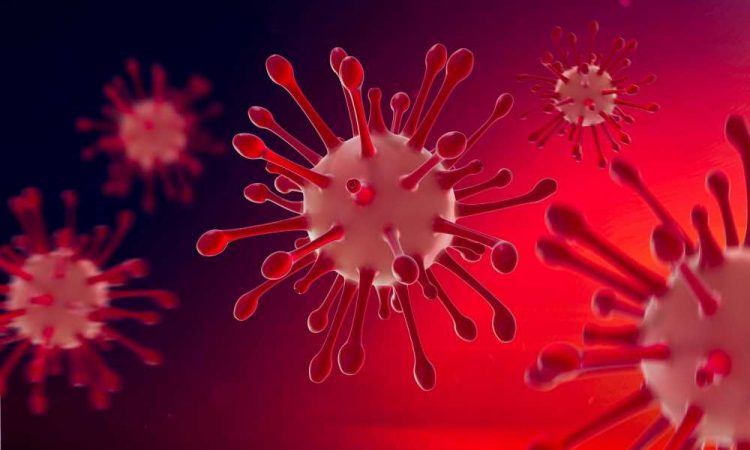In a recent study posted to the bioRxiv* server, researchers uncovered a novel mechanism that severe acute respiratory syndrome coronavirus 2 (SARS-CoV-2) and other coronaviruses (CoVs) use to exploit host antiviral immune system to facilitate their replication.

Background
Microribonucleic acid (miRNA) are small, non-coding RNAs that repress the translational efficiency of target messenger RNAs (mRNAs) via deadenylation and decapping. In their previous work, the authors found that SARS-CoV-2 non-structural protein 2 (NSP2) impairs the host antiviral immune system using miRNA-mediated translation repression. It interacts with GRB10 Interacting GYF Protein 2 (GIGYF2)/ eIF4E-homologous protein (4EHP) complex and blocks translation of the interferon 1-beta (IFN1-ß) encoding mRNA. However, it remains unknown whether NSP2 also affects miRNA-mediated silencing, which similarly utilizes the GIGYF2/4EHP complex for translational repression of target mRNAs.
About the study
In the present study, researchers investigated the role of the NSP2-GIGYF2/4EHP complex in miRNA-mediated silencing using co-immunoprecipitation (co-IP). They examined NSP2 interactions with miRNA-Induced Silencing Complex (miRISC), Argonaute (AGO), and other proteins in HEK293 cells. Further, the researchers examined the impact of NSP2 on the repression activity of miRNAs using the Firefly Luciferase (FL) mRNA harboring three times more miRNA (miR-20a) binding sites within its 3´ untranslated region (UTR). Following translational repression, miRNAs induce the degradation of their target mRNAs. Thus, the researchers also tested whether NSP2-enhanced miR-20a-induced silencing was due to enhanced mRNA degradation.
Study findings
Experiments with parental, GIGYF2-knockout (KO), and 4EHP-KO HEK293 cells transfected with miR-20 wildtype or miR-20 mutated reporter mRNAs showed marked de-repression of both miRNAs in 4EHP-KO and GIGYF2-KO cells compared with the parental cells. It showed that miR-20a-mediated repression of target mRNA was dependent on GIGYF2/4EHP complex.
Co-expression with NSP2 further augmented miR-20- mediated translation repression by ~30%. However, NSP2-induced enhancement of miR-20a-induced translational repression of target mRNAs did not result in mRNA degradation. Nevertheless, NSP2 played a crucial and all-pervasive role in augmenting miRNA-mediated silencing.
SARS-CoV-2 genome encodes multiple potential miRNAs, many of which target mRNAs that encode proteins involved in human immune-regulatory processes, e.g., nuclear factor kappa (NF-κB) and transforming growth factor-beta 1 (TGFß1) signaling pathways. In principle, NSP2 could accentuate the silencing mediated by antiviral miRNAs. However, it is more likely that augmented translational repression of viral and host miRNAs through NSP2 impairs the host's innate immunity against SARS-CoV-2 infection.
Also, there is a possibility that CoVs manipulate the expression pattern of antiviral miRNAs to avoid the potentially deleterious effects of NSP2-induced translation repression. Studies examining the expression of over 100 human miRNAs with the potential to affect the SARS-CoV-2 genome showed that their low expression in lung epithelial cells likely allowed CoVs to circumvent the antiviral effects of miRNAs facilitating their own replication inside the host cells.
Notably, the miRNA-mediated silencing machinery is prone to saturation due to its limited functional capacity. So the authors cautioned interpreting data obtained by transfection of miRNA-binding sites with caution. It, however, justifies why NSP2 did not significantly affect a reporter mRNA bearing six times more let-7 miRNA binding sites, repressed ~50-fold more than the mutated control.
Studies estimate that miRNAs influence ~60% of protein-coding mRNAs in humans, affecting biological processes, e.g., metabolism and homeostasis maintenance. Thus, dysregulated miRNA activity manifests as metabolic diseases and cancer. In cancers, global miRNA expression is often downregulated. One reason could be dysregulated expression of the miRNA biogenesis factor, Dicer.
NSP2-mediated control of miRNA-mediated translational repression during SARS-CoV-2 infection might have a substantial physiological impact. Thus, NSP2-originated peptides that preserve the GIGYF2/4EHP complex functionality could help modulate miRNA-mediated silencing, irrespective of SARS-CoV-2 infection.
Conclusions
According to the authors, the GIGYF2/4EHP complex possibly takes part in silencing target mRNAs via ribosome-associated quality control (RQC) or RNA-binding proteins, such as Tristetraprolin (TTP). TTP plays a crucial role in the regulation of the immune system and specific cancers by binding and inhibiting the expression of mRNAs containing the adenine (A)/uridine (U)-rich element.
Thus, future studies should examine the impact of NSP2 on additional functions of the GIGYF2/4EHP complex, such as the pathways controlled by RQC and TTP. Furthermore, future works should assess the effects of augmentation of NSP2-induced miRNA-mediated silencing on cancer tumorigenicity with diminished miRNA biosynthesis capacity.
*Important notice
bioRxiv publishes preliminary scientific reports that are not peer-reviewed and, therefore, should not be regarded as conclusive, guide clinical practice/health-related behavior, or treated as established information.
- Parisa Naeli, Xu Zhang, Patric Harris Snell, Susanta Chatterjee, Muhammad Kamran, Reese Jalal Ladak, Nick Orr, Thomas Duchaine, Nahum Sonenberg, Seyed Mehdi Jafarnejad. (2023). SARS-CoV-2 protein NSP2 enhances microRNA-mediated translational repression. bioRxiv. doi: https://doi.org/10.1101/2023.01.01.522328 https://www.biorxiv.org/content/10.1101/2023.01.01.522328v1
Posted in: Medical Science News | Medical Research News | Disease/Infection News
Tags: Adenine, Cancer, Coronavirus, Coronavirus Disease COVID-19, Genome, Growth Factor, Homologous, Immune System, immunity, Immunoprecipitation, Interferon, Knockout, Luciferase, Metabolism, Peptides, Protein, Respiratory, Ribosome, RNA, SARS, SARS-CoV-2, Severe Acute Respiratory, Severe Acute Respiratory Syndrome, Structural Protein, Syndrome, Transfection, Translation

Written by
Neha Mathur
Neha is a digital marketing professional based in Gurugram, India. She has a Master’s degree from the University of Rajasthan with a specialization in Biotechnology in 2008. She has experience in pre-clinical research as part of her research project in The Department of Toxicology at the prestigious Central Drug Research Institute (CDRI), Lucknow, India. She also holds a certification in C++ programming.
Source: Read Full Article
